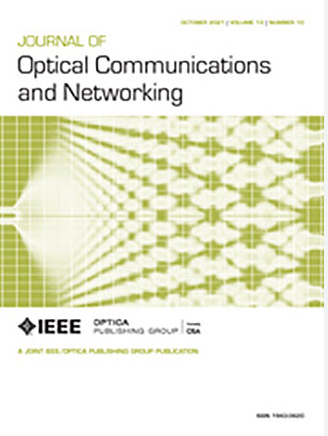模拟无线电和数字相干信号在多跨城域和PON上的异构传输,用于毫米波集中式ran中的带宽高效前传[特邀]
IF 4.3
2区 计算机科学
Q1 COMPUTER SCIENCE, HARDWARE & ARCHITECTURE
引用次数: 0
摘要
我们通过实验研究了异构模拟光纤无线电(ARoF)和数字相干光(DCO)信号在融合城域网络/无源光网络(PON)中的透明共存。我们的流线型设置采用通过光外差产生射频,这样载波和调制信号都可以集中产生,并通过城域网络和PON传输到天线站点。实验包括在68.75 GHz可重构光加/丢复用器(ROADM)信道带宽和1:32-1:128分路PON下传输8.8 Gbps毫米波信号和400 Gbps相干光信号。我们还分析了不同ROADM通道带宽、PON分割比、城域网络距离和穿越ROADM数量对DCO和ARoF信号性能的影响。结果表明,ARoF信号的误差矢量幅度(EVM)受到分配的带宽、roadm数量和整体网络损耗的显著影响,这为实现目标EVM水平所需的优化提供了见解。本文章由计算机程序翻译,如有差异,请以英文原文为准。
Heterogeneous transmission of analog radio and digital coherent signals over multispan metro and PON for bandwidth-efficient fronthaul in mmWave centralized RANs [Invited]
We experimentally investigate the transparent coexistence of heterogeneous analog radio-over-fiber (ARoF) and digital coherent optical (DCO) signals in a converged metro network/passive optical network (PON). Our streamlined setup employs RF generation via optical heterodyning so that both carrier and modulated signals can be generated centrally and transmitted to the antenna site across a metro network and a PON. The experiment includes the transmission of 8.8 Gbps mmWave signals and 400 Gbps coherent optical signals within a 68.75 GHz reconfigurable optical add/drop multiplexer (ROADM) channel bandwidth and a 1:32–1:128 split PON. We also analyze the impact of varying ROADM channel bandwidth, PON split ratios, metro network distance, and number of ROADMs traversed on the performance of DCO and ARoF signals. The results reveal that the error vector magnitude (EVM) of the ARoF signal is significantly influenced by the allocated bandwidth, the number of ROADMs, and the overall network loss, providing insights into optimizations necessary to achieve target EVM levels.
求助全文
通过发布文献求助,成功后即可免费获取论文全文。
去求助
来源期刊
CiteScore
9.40
自引率
16.00%
发文量
104
审稿时长
4 months
期刊介绍:
The scope of the Journal includes advances in the state-of-the-art of optical networking science, technology, and engineering. Both theoretical contributions (including new techniques, concepts, analyses, and economic studies) and practical contributions (including optical networking experiments, prototypes, and new applications) are encouraged. Subareas of interest include the architecture and design of optical networks, optical network survivability and security, software-defined optical networking, elastic optical networks, data and control plane advances, network management related innovation, and optical access networks. Enabling technologies and their applications are suitable topics only if the results are shown to directly impact optical networking beyond simple point-to-point networks.

 求助内容:
求助内容: 应助结果提醒方式:
应助结果提醒方式:


